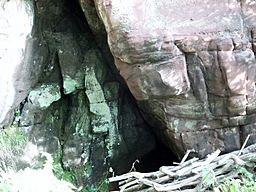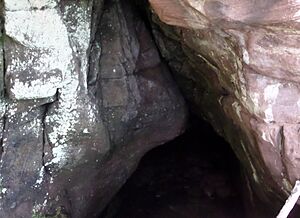The Holy Cave, Hunterston facts for kids
Quick facts for kids The Holy Cave |
|
|---|---|
| Hawking Craig Cave | |

The opening to the Holy Cave
|
|
| Location | Hunterston, North Ayrshire |
| OS grid | NS 1794 5079 |
| Length | 27 feet (8.2 m) |
| Elevation | 10 feet (3.0 m) |
| Entrances | 1 |
| Difficulty | Caution required |
| Hazards | Access to site |
| Access | By rough path |
The Holy Cave is a special place near Hunterston in West Kilbride, Scotland. Many people believe it is connected to Saint Mungo, who is also known as St Kentigern. This cave is sometimes called the Hawking Craig Cave. However, there are actually two caves in the Hawking Craig Wood area. The other one is called Smith's Cave, which is more like a rock shelter. Scientists have dug into the main Holy Cave and found signs that people lived there at different times over many centuries.
Contents
Exploring the Holy Cave
The Holy Cave is found about 300 yards from the northern end of some red sandstone cliffs. These cliffs stretch from Brigurd Point to Portencross. The cave was formed by strong waves hitting a weak spot in the rock long ago. Even though it was made by the sea, the cave now sits about 10 feet (3.0 m) above the old beach level.
The cave is not huge. It is about 6 feet (1.8 m) high, 6 feet (1.8 m) wide, and around 27 feet (8.2 m) long. The best way to reach it is to walk carefully along the bottom of the cliffs after entering Hawking Craig Wood near the 'Three Sisters' area.
The Mysterious Wishing Well
Near the Holy Cave, there was once a spring known as the 'Wishing Well'. Some old stories say this deep well was actually inside the cave or right at its entrance. The name 'Wishing Well' might come from an old Saxon word meaning "Wise man or Instructor's Well".
People used to visit this well most often on the first Sunday in May. They would collect its water because they believed it had special healing powers. It's even said that local ministers sometimes came to the well to baptize children using its holy water. The name 'Wishing Well' also suggests that people would make wishes there and leave offerings like coins.
History and Ancient Finds
In 1879, the Holy Cave was dug into by archaeologists. They found it was 27 feet long and 6 feet high and wide for the back 15 feet. The digging went down 6 feet until they reached solid rock. They found three main layers, each made of packed ashes and seashells. These layers were found at 18 inches, 30 inches, and 39 inches deep.
Many animal bones were discovered, including those from deer, cats, pigs, horses, sheep, goats, oxen, and rabbits. Horse bones were found between the top and middle layers, while dog bones were between the middle and bottom layers.
A very interesting find was a bone object with a rectangular hole, found in the middle layer. A flint tool was found just above the bottom layer. They also found an object made of slate. Some pieces of pottery were discovered too. One was rough and reddish without glaze, and another was thinner with a green-brown glaze, similar to pottery from the Scottish Medieval period. Today, the National Museum of Scotland keeps the bone tool and some of the pottery pieces.
It's likely that a shelter once stood at the cave's entrance, but no clear signs of it remain. There are some marks on the nearby rock face that look man-made. However, there are no religious symbols or drawings. This might be because the soft red sandstone easily wears away from rain and wind.
Other Nearby Caves
The Ardeer Cave
There is another cave near the old Ardeer House in Stevenston. This cave used to have a stone frame and an iron grate over a hole in its roof. This suggests it was used as a special grotto in the 1800s. The visible parts looked like a souterrain (an underground passage), but these are very rare in southwest Scotland. The passage inside is lined with dry stone walls and covered with large capstones. It leads into a natural part of the cave that might have been formed by waves. Scientists have found undisturbed layers of soil, signs of people living there, a fireplace, bones, and a piece of glass.
St Molaise's Cave
A similar cave or rock shelter can be found on Holy Island, which is off the coast of Arran. This cave is linked to Saint Molaise, an early Irish saint who lived in the 500s and 600s. He was an abbot (a leader of monks) in Ireland. There are also similarities between the Holy Cave and Saint Ninian's Cave at Glasserton in Dumfries and Galloway.
Local Stories and Legends
The name 'Hawking Craig' comes from a medieval practice. In those times, people would collect young sparrowhawks and goshawks from the cliffs for the sport of falconry, which is hunting with trained birds of prey.
A very famous item, the Hunterston Brooch, was found by workers at the Hawking Craig in 1826.
Before the Battle of Largs in 1263, a small fight is said to have happened on the raised beach in front of the Holy Cave. There were once piles of stones, called cairns, that people believed were the graves of Vikings killed in that battle. In the early 1800s, a man named Wilson saw several graves made of six stones that only held ashes. He also saw a large cairn at the bottom of the cliff where the fight happened, and coins were found there. These graves were later removed.
A local legend tells of three sisters named Meg, Jean, and Lizzie. People believed they were witches who caused a big storm that damaged King Haco's fleet during the battle. The cliffs known as the 'Three Sisters' are named after them.
Images for kids



